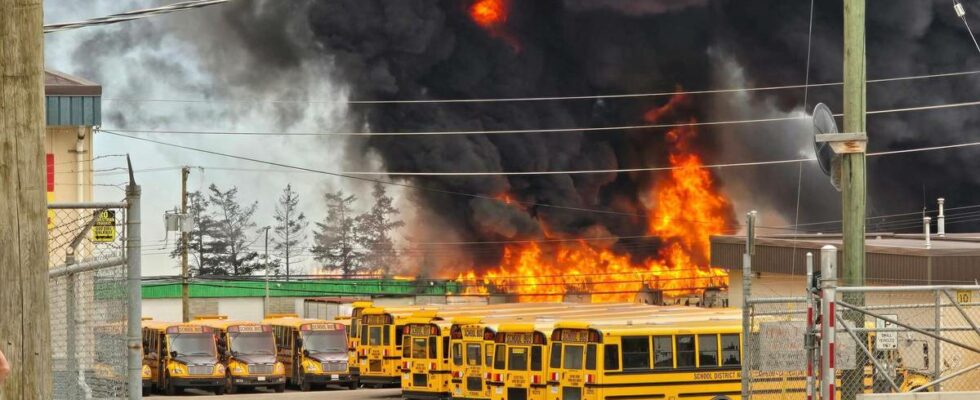– There is a lot of traffic. The smoke is quite thick. We have masks in the car, says Carolyn Campbell to the AP news agency. She and 25,000 others flee from Jasper National Park in Alberta. Just one of several places where the flames are raging. On Thursday, the flames reached all the way to the small alpine village of Jasper, causing damage to buildings. The forest fires are the biggest to ever hit the city, writes the regional newspaper Edmonton Journal. Carolyn Campbell sat in a long line of cars as the wildfire raged. Photo: Carolyn Campbell / AP Large and intense wildfires have developed throughout the spring and summer in Canada, Russia and Alaska. The fires bring with them large amounts of harmful smoke and greenhouse gas emissions. This is reported by the Copernicus Atmospheric Monitoring Service (Cams), which is part of the EU’s climate service. It is normal for fires to occur in the boreal forest in the summer, emphasize the researchers who have monitored the fires closely over several years. – During this time, we have noticed some particularly extreme forest fire emissions and atmospheric impacts, especially in Canada, eastern Russia and the Arctic, says senior researcher Mark Perrington at Cams. – The current forest fires are already at record levels in some regions. Since half of the summer still remains, we expect more extreme fire emissions, he says. Large red flames and clouds of black smoke billow from behind a row of yellow school buses in the town of Williams Lake in British Columbia. Photo: Spencer Stratton / Reuters That’s how much the fires release In Canada, the forest fires have mainly been in the west of the country, in the provinces of British Columbia and Alberta. Recently, it has spread to neighboring regions such as Alaska, the Yukon, the Northwest Territories and Saskatchewan. In Russia, there have been fires in the region of Sakha, Amur Oblast and Zabaykalsky Kraj in June and July. Cams has the following estimates for emissions from June to 15 July. The fires from Amur Oblast alone account for 17.2 megatons of carbon. From British Columbia it is 11.08 megatonnes From Alberta it is 12.23 megatonnes The researchers measure the emissions in carbon instead of CO₂, because they also look at the effect on air quality. But there are around 90 percent direct emissions of CO₂, explains Johannes Kaiser, senior researcher at NILU. In comparison, Norway’s emissions for the whole of 2023 were 46.6 megatonnes, or million tonnes, of CO2 equivalents. The fires and emissions are still well below the record year 2023 so far. Graphics showing fires in Canada, marked with flame symbols. Photo: FIRMS / NASA How much CO₂ can the forest store? Fires are a natural part of the boreal forest and play an important role in the ecosystem. In a stable and healthy state, emissions from forest fires will be absorbed as plants and trees grow back. The forest stores more carbon than it emits. An important question is what happens to this balance when man-made climate change contributes to forest fires. – When you get a warmer Arctic and a warmer climate in the boreal region, with higher temperatures and less precipitation, you get periods of drought. And then you get an area that is more exposed to fire, explains Kaiser at NILU. Aerial view of large wall of smoke moving over Wabush, eastern Canada. July 12. Photo: SIMON CONTANT / AFP The Arctic is also warming faster than the rest of the earth. – That is why you get these situations in higher latitudes, such as Siberia and Canada. Drought and fires can also affect how much trees and plants in the forest can grow, and thus their ability to absorb CO₂, says Kaiser. – What happens with climate change is that the forest does not grow back in the same condition as it was before, he says. Forest fire danger in Norway The danger of forest fire is also increasing in northern Norway these days. – It is the same mechanism, but on a totally different scale, says Kaiser. Smoke from wildfires contains particulate matter and is dangerous to inhale, because it can find its way into lung tissue or the bloodstream. Last year, smoke from Canada’s enormous forest fires reached as far as Norway. But after the long journey, the effect on air quality was small, says Kaiser. The fires that are now raging in our neighboring country Russia will not harm Norwegians either. It blows west and will affect people in Asia. Recommends building “fire smart” Canadian CBC has spoken to several experts about how the country should prepare and adapt to upcoming, intense forest fires. The authorities should help people fireproof their homes, and all future buildings should be built “fire smart”. Two people stand by a water’s edge and look out over a landscape colored orange by huge wildfires in Canada in 2023. Photo: DARRYL DYCK / AP People should remove leaves and other flammable material from their property. Perhaps the opportunity to travel freely in exposed nature should also be limited. Often, all it takes is a small spark to ignite a catastrophic fire. Large infrastructure projects should also be investigated for fire safety and vulnerability. Better conducted controlled fires, which remove highly flammable material from the forest floor, can help prevent uncontrolled fires. The authorities should also use the expertise of local and indigenous people, who know the vulnerable areas best, say the experts. Published 25/07/2024, at 08.11 Updated 25.07.2024, at 11.58
ttn-69
– Expect more extreme fire emissions – news Urix – Foreign news and documentaries

